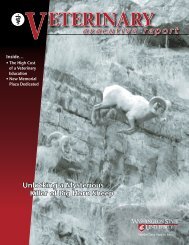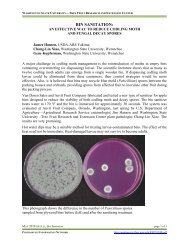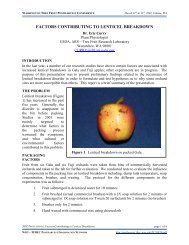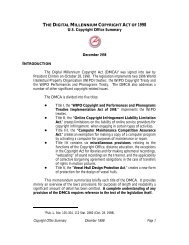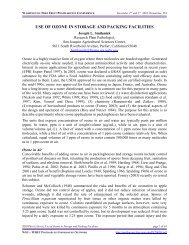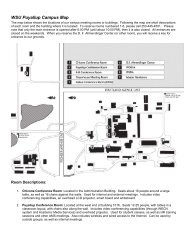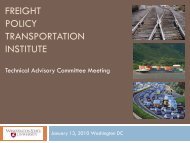No-Till: The Quiet Revolution - Research - Washington State University
No-Till: The Quiet Revolution - Research - Washington State University
No-Till: The Quiet Revolution - Research - Washington State University
You also want an ePaper? Increase the reach of your titles
YUMPU automatically turns print PDFs into web optimized ePapers that Google loves.
agriculture<strong>No</strong>-<strong>Till</strong>:the <strong>Quiet</strong> <strong>Revolution</strong><strong>The</strong> age-old practice of turning the soil before planting a newcrop is a leading cause of farmland degradation. Many farmersare thus looking to make plowing a thing of the pastBy David R. Huggins and John P. Reganold© 2008 SCIENTIFIC AMERICAN, INC.70 SCIENTIFIC AMERICAN July 2008
NO-TILL PIONEER John Aeschliman beganexperimenting with the technique in1974 out of concern over the soil erosionthat was taking place in <strong>Washington</strong><strong>State</strong>’s sloping Palouse region, wherehis farm is located.ANDY ANDERSONJohn Aeschliman turns over a shovelful oftopsoil on his 4,000-acre farm in the Palouseregion of eastern <strong>Washington</strong> <strong>State</strong>. <strong>The</strong>black earth crumbles easily, revealing a porousstructure and an abundance of organic matterthat facilitate root growth. Loads of earthwormsare visible, too—another healthy sign.Thirty-four years ago only a few earthworms,if any, could be found in a spadeful of his soil.Back then, Aeschliman would plow the fieldsbefore each planting, burying the residues fromthe previous crop and readying the ground forthe next one. <strong>The</strong> hilly Palouse region had beenfarmed that way for decades. But the tillage wastaking a toll on the Palouse, and its famouslyfertile soil was eroding at an alarming rate.Convinced that there had to be a better way towork the land, Aeschliman decided to experimentin 1974 with an emerging method knownas no-till farming.Most farmers worldwide plow their land inpreparation for sowing crops. <strong>The</strong> practice ofturning the soil before planting buries crop residues,animal manure and troublesome weedsand also aerates and warms the soil. But clearingand disturbing the soil in this way can alsoleave it vulnerable to erosion by wind and water.<strong>Till</strong>age is a root cause of agricultural land degradation—oneof the most serious environmentalproblems worldwide—which poses a threatto food production and rural livelihoods, particularlyin poor and densely populated areas ofthe developing world [see “Pay Dirt,” by DavidR. Montgomery, on page 76]. By the late 1970sin the Palouse, soil erosion had removed 100percent of the topsoil from 10 percent of thecropland, along with another 25 to 75 percentof the topsoil from another 60 percent of thatland. Furthermore, tillage can promote the runoffof sediment, fertilizers and pesticides intorivers, lakes and oceans. <strong>No</strong>-till farming, in contrast,seeks to minimize soil disruption. Practitionersleave crop residue on the fields after harvest,where it acts as a mulch to protect the soilfrom erosion and fosters soil productivity. Tosow the seeds, farmers use specially designedseeders that penetrate through the residue to theundisturbed soil below, where the seeds can germinateand surface as the new crop.In its efforts to feed a growing world population,agriculture has expanded, resulting in agreater impact on the environment, humanhealth and biodiversity. But given our currentknowledge of the planet’s capacity, we now realizethat producing enough food is not enough—© 2008 SCIENTIFIC AMERICAN, INC.KEY CONCEPTSn Conventional plow-basedfarming leaves soil vulnerableto erosion and promotesagricultural runoff.n Growers in some parts ofthe world are thus turningto a sustainable approachknown as no-till that minimizessoil disturbance.n High equipment costs anda steep learning curve,among other factors, arehindering widespread adoptionof no-till practices.—<strong>The</strong> EditorsSCIENTIFIC AMERICAN 71
[history]Agriculture milestones<strong>The</strong> roots of both no-till and tillage-based farmingmethods run deep, but eventually the latterapproach predominated, thanks to the evolution ofthe plow. Over the past few decades, however,advances in herbicides and machinery have madeno-till practical on a commercial scale.[THE AUTHORs]8000 B.C.Planting stick, the earliest version of no-till, enablesthe planting of seeds without cultivation.Scratch plowthe earliest plow, clears a path through the ground cover and createsa furrow into which seeds can be placed.6000 B.C.Draft animals replace humans in powering the plow.3500 B.C.Plowshare, a wedge-shaped implement tipped withan iron blade, loosens the top layer of soil.1100 A.D.?Moldboard plowhas a curved blade (the moldboard) thatinverts the soil, burying weeds and residues.Mid-1800sSteel moldboard plowinvented by John Deerein 1837, is ableto break upprairie sod.Early 1900sTractorscan pull multiple plows at once.1940s –1950sHerbicides such as 2,4-D,atrazine and paraquat enable farmers to manageweeds with less tillage.1960s<strong>No</strong>-till seedersslice open a small groovefor seeds, keeping soildisturbance to a minimum.David R. Huggins (left) is a soilscientist with the USDA-Agricultural<strong>Research</strong> Service, Land Managementand Water Conservation<strong>Research</strong> Unit in Pullman, Wash.He specializes in conservationcropping systems and their influenceon the cycling and flowof soil carbon and nitrogen. John P.Reganold (right), Regents Professorof Soil Science at <strong>Washington</strong><strong>State</strong> <strong>University</strong> at Pullman,specializes in sustainable agriculture.This is his third article forScientific American.it must also be done sustainably. Farmers needto generate adequate crop yields of high quality,conserve natural resources for future generations,make enough money to live on, and besocially just to their workers and community[see “Sustainable Agriculture,” by John P. Reganold,Robert I. Papendick and James F. Parr;Scientific American, June 1990]. <strong>No</strong>-tillfarming is one system that has the potential tohelp realize this vision of a more sustainableagriculture. As with any new system, there arechallenges and trade-offs with no-till. Nevertheless,growers in some parts of the world areincreasingly abandoning their plows.Plowing AheadPeople have used both no-till and tillage-basedmethods to produce food from the earth eversince they started growing their own cropsaround 10,000 years ago. In the transition fromhunting and gathering to raising crops, ourNeolithic predecessors planted garden plotsnear their dwellings and foraged for other foodsin the wild. Some performed the earliest versionof no-till by punching holes in the land with astick, dropping seeds in each divot and then coveringit with soil. Others scratched the groundwith a stick, an incipient form of tillage, to placeseeds under the surface. Thousands of farmersin developing countries still use these simplemethods to sow their crops.In time, working the soil mechanicallybecame the standard for planting crops andcontrolling weeds, thanks to the advent of theplow, which permitted the labor of a few to sustainmany. <strong>The</strong> first such tools were scratchplows, consisting of a frame holding a verticalwooden post that was dragged through the top-STEWART HIGGINS <strong>Washington</strong> <strong>State</strong> <strong>University</strong> (Huggins and Reganold); wu hong epa/Corbis (scratch plow);ralf roletschek (moldboard plow); hugh talman Smithsonian Images (John Deere plow);lane lambert iStockPhoto (tractor); andy anderson (no-till seeder)72 SCIENTIFIC AMERICAN © 2008 SCIENTIFIC AMERICAN, INC.July 2008
DEAN CONGER National Geographic /Getty Imagessoil. Two people probably operated the earliestversion of this device, one pulling the tool andthe other guiding it. But the domestication ofdraft animals—such as oxen in Mesopotamia,perhaps as early as 6000 B.C.—replaced humanpower. <strong>The</strong> next major development occurredaround 3500 B.C., when the Egyptians and theSumerians created the plowshare—a wedgeshapedwooden implement tipped with an ironblade that could loosen the top layer of soil. Bythe 11th century, the Europeans were using anelaboration of this innovation that included acurved blade called a moldboard that turnedthe soil over once it was broken open.Continuing advancements in plow designenabled the explosion of pioneer agricultureduring the mid-1800s; farmers cultivated grassdominatednative prairies in eastern Europe,South Africa, Canada, Australia, New Zealandand the U.S., converting them to corn, wheatand other crops. One such region, the tall-grassprairie of the Midwestern U.S., had resistedwidespread farming because its thick, sticky sodwas a barrier to cultivation. But in 1837 an Illinoisblacksmith named John Deere invented asmooth, steel moldboard plow that could breakup the sod. Today this former grassland, whichincludes much of the famous Corn Belt, is hometo one of the most agriculturally productiveareas in the world.Agricultural mechanization continuedthrough the early 1900s with the developmentof many tools that helped farmers cultivate theearth ever more intensively, including tractorsthat could pull multiple plows at once. <strong>Till</strong>agepractices were about to undergo profound scrutiny,however. <strong>The</strong> Dust Bowl era between 1931and 1939 exposed the vulnerability of plowbasedagriculture, as wind blew away precioustopsoil from the drought-ravaged southernplains of the U.S., leaving behind failed cropsand farms. Thus, the soil conservation movementwas born, and agriculturalists began toexplore reduced tillage methods that preservecrop residues as a protective ground cover. Spurringthe movement was the controversial publicationin 1943 of Plowman’s Folly, by agronomistEdward Faulkner, who challenged thenecessity of the plow. Faulkner’s radical propositionbecame more tenable with the developmentof herbicides—such as 2,4-D, atrazine andparaquat—after World War II, and research onmodern methods of no-till agriculture began inearnest during the 1960s.Considering the pivotal role the plow hasADOPTIONHURDLESAlthough no-till is theoreticallyapplicable to most farmlandaround the world, the costof the requisite equipment andherbicides is prohibitive formany growers, most of whomhave small farms. Necessarycosts aside, poverty itself leadsthese farmers to use cropresidues and animal dung forfuel, for example, and to till theland for short-term gains ratherthan investing in long-termstewardship.Of 525 million farms worldwide,roughly 85 percent areless than five acres. <strong>The</strong> overwhelmingmajority of thesesmall farms—about 87 percent—arelocated in Asia(above); Africa is home to8 percent. <strong>The</strong> adoption ofno-till farming in these regions,where the potential benefitsare the greatest, is practicallynegligible.come to play in farming, conceiving a way to dowithout it has proved quite challenging, requiringthe reinvention of virtually every aspect ofagricultural production. But specially designedseeders have been evolving since the 1960s tomeet the unique mechanization requirements ofno-till farming. <strong>The</strong>se new seeders, along withchemical herbicides, are two of the main technologiesthat have at last enabled growers to effectivelypractice no-till on a commercial scale.Signing Up for <strong>No</strong>-<strong>Till</strong>Farmers today prepare for planting in ways thatdisturb the soil to varying degrees. <strong>Till</strong>age witha moldboard plow completely turns over thefirst six to 10 inches of soil, burying most of theresidue. A chisel plow, meanwhile, only fracturesthe topsoil and preserves more surface residue.In contrast, no-till methods merely createin each planted row a groove just half an inch tothree inches across into which seeds can bedropped, resulting in minimal overall soil disturbance.In the U.S., no-till agriculture fitsunder the broader U.S. Department of Agriculturedefinition of conservation tillage. Conservationtillage includes any method that retainsenough of the previous crop residues such thatat least 30 percent of the soil surface is coveredafter planting. <strong>The</strong> protective effects of suchresidues are considerable. According to theUSDA’s National Resources Inventory data, soilerosion from water and wind on U.S. croplanddecreased 43 percent between 1982 and 2003,with much of this decline coming from the adoptionof conservation tillage.Soil protection is not the only benefit of notill.Leaving crop residues on the soil surfacehelps to increase water infiltration and limit runoff.Decreased runoff, in turn, can reduce pollutionof nearby water sources with transportedsediment, fertilizers and pesticides. <strong>The</strong> residuesalso promote water conservation by reducingevaporation. In instances where water availabilitylimits crop production, greater water conservationcan mean higher-yielding crops or newcapabilities to grow alternative crops.<strong>The</strong> no-till approach also fosters the diversityof soil flora and fauna by providing soil organisms,such as earthworms, with food from theresidues and by stabilizing their habitat. Togetherwith associated increases in soil organic matter,these conditions encourage soils to developa more stable internal structure, further improvingthe overall capacity to grow crops and tobuffer them against stresses caused by farmingwww.SciAm.com © 2008 SCIENTIFIC AMERICAN, INC.SCIENTIFIC AMERICAN 73
[A PRIMER]HOW NO-TILL STACKS UPThree farming systems for a corn-soybean crop rotation in the U.S. Corn Belt are contrasted here. <strong>No</strong>-till requires the fewest passes over a field.Soybean andcorn residuescover soilsurface,conservingwater andreducingerosion by 70to 100percentNO-TILL1. Apply herbicide2. Plant3. Apply herbicide4. HarvestAfter harvest,standing corn stalksand fallen grainprovide shelter andfood for wildlife (birdnot drawn to scale)CONSERVATION TILLAGE1. <strong>Till</strong> with chisel plow, buryingup to 50 percentof crop residue2. <strong>Till</strong> with field cultivator3. Plant4. Apply herbicide5. <strong>Till</strong> with row cultivator6. HarvestSoybean residuecovers 30 percentof the soil surface,halving erosionCONVENTIONAL TILLAGE1. <strong>Till</strong> with moldboard plow,burying up to 90 percent of crop residue2. <strong>Till</strong> with disk to smooth the ground surface3. <strong>Till</strong> with field cultivator to preparethe seedbed for planting4. <strong>Till</strong> with harrows to smooth seedbed5. Plant6. Apply herbicide7. <strong>Till</strong> with row cultivator8. HarvestSoil surface is bare,leaving it vulnerableto erosion by windand water0 inches10Dark surfaceenhances soilwarming, whichpromotes corngrowth20Plow can smear and compactthe soil, forming a “pan” thatrestricts water movementand root growth30Earthworms proliferate, creatingchannels that foster root growthGranular soilstructureachieved withno-till improveswater infiltration,reducing erosionConservationtillage leadsto granularsoil structureinterspersedwith clods<strong>Till</strong>age disrupts granularsoil structure, forminglarge clods that limitroot growth and smallparticles that can bedislodged by raindrops,leading to erosionoperations or environmental hazards. <strong>No</strong>-tillcan thus enable the more sustainable farming ofmoderately to steeply sloping lands that are atelevated risk of erosion and other problems.Wildlife, too, gains from no-till, becausestanding crop residues and inevitable harvestlosses of grain provide cover and food for uplandgame birds and other species. In a study publishedin 1986, researchers in Iowa found 12bird species nesting in no-till fields, comparedwith three species in tilled fields.Furthermore, reducing tillage increases soilcarbon sequestration, compared with conventionalmoldboard plowing. One of agriculture’smain greenhouse gas mitigation strategies is soilcarbon sequestration, wherein crops removecarbon dioxide from the atmosphere duringphotosynthesis, and nonharvested residues androots are converted to soil organic matter, whichis 58 percent carbon. About half of the overallpotential for U.S. croplands to sequester soilcarbon comes from conservation tillage, includingno-till.In addition, no-till can offer economic advantagesto farmers. <strong>The</strong> number of passes over afield needed to establish and harvest a crop withno-till typically decreases from seven or more tofour or fewer. As such, it requires 50 to 80 per-KEVIN HAND74 SCIENTIFIC AMERICAN © 2008 SCIENTIFIC AMERICAN, INC.July 2008
daniela naomi molnarcent less fuel and 30 to 50 percent less labor thantillage-based agriculture, significantly loweringproduction costs per acre. Although specializedno-till seeding equipment can be expensive, withsome sophisticated seeders priced at more than$100,000, running and maintaining other tillageequipment is no longer necessary, loweringthe total capital and operating costs of machineryrequired for crop establishment by up to 50percent. With these savings in time and money,farmers can be more competitive at smallerscales, or they can expand and farm more acres,sometimes doubling farm size using the sameequipment and labor. Furthermore, many farmersappreciate that the time they once devoted torather mundane tillage tasks they can insteadspend on more challenging aspects of farming,family life or recreation, thereby enhancing theiroverall quality of life.Betting the Farm<strong>No</strong>-till and other conservation tillage systemscan work in a wide range of climates, soils andgeographic areas. Continuous no-till is alsoapplicable to most crops, with the notable exceptionsof wetland rice and root crops, such aspotatoes. Yet in 2004, the most recent year forwhich data are available, farmers were practicingno-till on only 236 million acres worldwide—not even 7 percent of total global cropland.Of the top five countries with the largestareas under no-till, the U.S. ranks first, followedby Brazil, Argentina, Canada and Australia.About 85 percent of this no-till land liesin <strong>No</strong>rth and South America. In the U.S., roughly41 percent of all planted cropland was farmedusing conservation tillage systems in 2004,compared with 26 percent in 1990. Most of thatgrowth came from expanded adoption of notill,which more than tripled in that time, to thepoint where it was practiced on 22 percent ofU.S. farmland. This no doubt partly reflects thefact that U.S. farmers are encouraged to meetthe definition of conservation tillage to participatein government subsidy and other programs.In South America, adoption of no-till farminghas been relatively rapid as a result of coordinatedefforts by university agricultural-extensioneducators and local farm communities to developviable no-till cropping systems tailored totheir particular needs.On the other hand, adoption rates are low inEurope, Africa and most parts of Asia. Embracingno-till has been especially difficult in developingcountries in Africa and Asia, becauseSoil Loss RatioTWO SIDESOF NO-TILLPayoffsReduces soil erosionConserves waterImproves soil healthReduces fuel and labor costsReduces sediment and fertilizerpollution of lakes and streamsSequesters carbonTrade-offsTransition from conventionalfarming to no-till is difficultNecessary equipment is costlyHeavier reliance on herbicidesPrevalence of weeds, diseaseand other pests may shift inunexpected waysMay initially require morenitrogen fertilizerCan slow germination andreduce yieldsSoil saver10.60.2020 60 100Ground Cover(percent)Leaving 30 percent of the soilsurface covered with residuereduces erosion by half as comparedwith bare, fallow soil. Andleaving 50 to 100 percent of thesurface covered throughout theyear, as no-till does, reduces soilerosion dramatically.farmers there often use the crop residues for fuel,animal feed and other purposes. Furthermore,the specialized seeders required for sowingcrops and the herbicides needed for weed controlmay not be available or can be prohibitivelyexpensive for growers in these parts of theworld. Meanwhile, in Europe, an absence ofgovernment policies promoting no-till, alongwith elevated restrictions on pesticides (includingherbicides), among other variables, leavesfarmers with little incentive to adopt thisapproach.Changing from tillage-based farming to notillis not easy. <strong>The</strong> difficulty of the transition,together with the common perception that notillincurs a greater risk of crop failure or lowernet returns than conventional agriculture, hasseriously hindered more widespread adoptionof this approach. Although farmers accept thatagriculture is not a fail-safe profession, theywill hesitate to adopt a new farming practice ifthe risk of failure is greater than in conventionalpractice. Because no-till is a radical departurefrom other farming practices, growers makingthe switch to no-till experience a steep learningcurve. In addition to the demands of differentfield practices, the conversion has profoundimpacts on farm soils and fields. Different pestspecies can arise with the shift from tillagebasedagriculture to no-till, for instance. Andthe kinds of weeds and crop diseases can change.For example, the elevated moisture levels associatedwith no-till can promote soil-borne fungaldiseases that tillage previously kept in check.Indeed, the discovery of new crop diseases hassometimes accompanied the shift to no-till.Some of the changes that follow from no-tillcan take years or even decades to unfold, andfarmers need to remain vigilant and adaptableto new, sometimes unexpected, situations, suchas those that arise from shifts in soil and residueconditions or fertilizer management. Duringthis transition, there is a real risk of reducedyields and even failed crops. In the Palouse, forexample, some farmers who attempted no-tillin the 1980s are no longer in business. Consequently,farmers looking to switch to no-tillshould initially limit the converted acreage to10 to 15 percent of their total farm.Farmers who are new to no-till techniquesoften visit successful operations and form localor regional support groups, where they shareexperiences and discuss specific problems. Butthe advice they receive in areas with limited notilladoption can be incomplete or contradictory,www.SciAm.com © 2008 SCIENTIFIC AMERICAN, INC.SCIENTIFIC AMERICAN 75
[A CASE FOR NO-TILL]PAY DIRTand gaps in knowledge, experience or technologycan have potentially disastrous outcomes. Ifthe perception that no-till is riskier than conventionaltechniques develops in a farming community,banks may not underwrite a no-till farmer’sloan. Alternatively, growers who are leasing landmay find that the owners are opposed to no-tillbecause of fears that they will not get paid asmuch. Improving the quality of information<strong>The</strong> slow pace at which soil rebuilds makes its conservation essential By David R. Montgomeryexchange among farmers, universities, agribusinessesand government agencies will no doubt goa long way toward overcoming these obstacles.Yet even in the hands of a seasoned no-tillfarmer, the system has drawbacks. <strong>No</strong>-till cropproduction on fine-textured, poorly drainedsoils can be particularly problematic, oftenresulting in decreased yields. Yields of no-tillcorn, for instance, are often reduced by 5 to 10fundamental drawback of conventional farming is that it fostersA topsoil erosion, especially on sloping land. <strong>Till</strong>age leaves theground surface bare and vulnerable to runoff, and each pass of the plowpushes soil downhill. As a result, the soil thins over time. How long thisprocess takes depends not only on how fast plowing pushes soil downhill—andwind or runoff carries it away—but also on how fast theunderlying rocks break down to form new soil.In the 1950s, when the Soil Conservation Service (now known as theNatural Resources Conservation Service) began defining tolerable ratesof soil erosion from agricultural land, hardly any data on rates of soilproduction were available. <strong>The</strong> agency thus determined the so-calledsoil loss tolerance values, or T values, on the basis of what farmers coulddo to reduce erosion without“undue economicimpact” using conventionalfarming equipment. <strong>The</strong>se Tvalues correspond to asmuch as an inch of erosionin 25 years. But recentresearch has shown thaterosion rate to be far fasterthan the rate at which soilrebuilds.Over the past severaldecades, scientists havedetermined that measuringthe soil concentrations ofcertain isotopes that form ata known rate permits directquantification of soil productionrates. Applying thistechnique to soils in temperateregions in coastal California and southeastern Australia, geologistArjun Heimsath of Arizona <strong>State</strong> <strong>University</strong> and his colleagues found soilproduction rates ranging from 0.00118 to 0.00315 inch a year. As such,it takes 300 to 850 years to form an inch of soil in these places. My ownrecent global compilation of data from soil production studies, publishedlast year in the Proceedings of the National Academy of SciencesUSA, revealed an average rate of 0.00067 to 0.00142 incha year—equivalent to 700 to 1,500 years to form an inch of soil.<strong>The</strong> soil on undisturbed hillsides in temperate and tropical latitudes isgenerally one to three feet thick. With natural soil production rates ofWIND EROSION in the Southern Plains of the U.S. during the Dust Bowl erarevealed the perils of plow-based farming.centuries to millennia per inch and soil erosion rates of inches per centuryunder plow-based agriculture, it would take just several hundred to acouple of thousand years to plow through the soil in these regions. Thissimple estimate predicts remarkably well the life span of major agriculturalcivilizations around the world. With the exception of the fertile rivervalleys along which agriculture began, civilizations generally lasted 800to 2,000 years, and geoarchaeological studies have now shown a connectionbetween soil erosion and the decline of many ancient cultures.Clearly, then, if we are to conserve resources for future generations,we need alternatives to conventional farming practices. <strong>No</strong>-till systemssimultaneously reduce the erosive force of runoff and increase the abilityof the ground to hold onto soil, making these methods remarkably effectiveat curbing erosion. In astudy published in 1993,researchers at the <strong>University</strong> ofKentucky found that no-tillmethods decreased soil erosionby a whopping 98 percent. Morerecently, investigators at the<strong>University</strong> of Tennessee reportedthat no-till tobacco farmingreduced soil erosion by morethan 90 percent over conventionaltobacco cultivation.Although the effect of no-till onerosion rates depends on a numberof local factors, such as thetype of soil and the crop, it canbring soil erosion rates downclose to soil production rates.In the mid-1990s Cornell<strong>University</strong> researchers estimatedthat undoing damage caused by soil erosion would cost the U.S.$44 billion a year, and that it would take an annual investment of about$6 billion to bring erosion rates on U.S. cropland in line with soil production.<strong>The</strong>y also estimated that each dollar invested in soil conservationwould save society more than $5. Because it is prohibitively expensiveto put soil back on the fields once it leaves, the best, most cost-effectivestrategy for society at large is to keep it on the fields in the first place.David R. Montgomery is a professor of geomorphology at the <strong>University</strong>of <strong>Washington</strong> and author of Dirt: <strong>The</strong> Erosion of Civilizations.GETTY IMAGES76 SCIENTIFIC AMERICAN © 2008 SCIENTIFIC AMERICAN, INC.July 2008
KEVIN HANDpercent on these kinds of soils, compared withyields with conventional tillage, particularly innorthern regions. And because the crop residueblocks the sun’s rays from warming the earth tothe same degree as occurs with conventionaltillage, soil temperatures are colder in the spring,which can slow seed germination and curtailthe early growth of warm-season crops, such ascorn, in northern latitudes.In the first four to six years, no-till demandsthe use of extra nitrogen fertilizer to meet thenutritional requirements of some crops, too—upto 20 percent more than is used in conventionaltillage systems—because increasing organic matterat the surface immobilizes nutrients, includingnitrogen. And in the absence of tillage, farmersdepend more heavily on herbicides to keepweeds at bay. Herbicide-resistant weeds arealready becoming more common on no-till farms.<strong>The</strong> continued practice of no-till is thereforehighly dependent on the development of new herbicideformulations and other weed managementoptions. Cost aside, greater reliance on agrichemicalsmay adversely affect nontarget species orcontaminate air, water and soil.Integrating <strong>No</strong>-<strong>Till</strong><strong>No</strong>-till has the potential to deliver a host of benefitsthat are increasingly desirable in a worldfacing population growth, environmental degradation,rising energy costs and climate change,among other daunting challenges. But no-till isnot a cure-all; such a thing does not exist inagriculture. Rather it is part of a larger, evolvingvision of sustainable agriculture, in which adiversity of farming methods from no-till toorganic—and combinations thereof—is consideredhealthy. We think that ultimately all farmersshould integrate conservation tillage, andno-till if feasible, on their farms.Future no-till farming will need to employmore diverse pest and weed management strategies,including biological, physical and chemicalmeasures to lessen the threat of pesticide resistance.Practices from successful organic farmingsystems may be instructive in that regard. Onesuch technique, crop rotation—in which farmersgrow a series of different crops in the samespace in sequential seasons—is already helpingno-till’s war on pests and weeds by helping tobreak up the weed, pest and disease cycles thatarise when one species is continuously grown.To that end, the capacity to grow a diverseselection of economically viable crops wouldadvance no-till farming and make it more[WHERE IT IS USED]NO-TILL ACREAGELess than 7 percent of the world’s cropland is farmed using no-till methods. Of these236 million acres, about 85 percent are in <strong>No</strong>rth and South America.SouthAfrica741,000Bolivia1,359,000Spain741,000Uruguay650,000U.S.62,528,000Argentina45,144,000Venezuela741,000Chile297,000 252,000ColombiaChina247,000Paraguay4,201,000appealing to farmers. But the current emphasison corn to produce ethanol in the MidwesternCorn Belt, for instance, is promoting monoculture—inwhich a single crop, such as corn, isgrown over a wide area and replanted everyyear—and will likely make no-till farming moredifficult in this region. Experts continue todebate the merits of growing fuel on farmland,but if we decide to proceed with biofuel crops,we will need to consider using no-till with croprotation to produce them sustainably. Developmentof alternative crops for bioenergy productionon marginal lands, including perennialssuch as switchgrass, could complement and promoteno-till farming, as would perennial grainfood crops currently under development [see“Future Farming: A Return to Roots?” by JerryD. Glover, Cindy M. Cox and John P. Reganold;Scientific American, August 2007].Today, three decades after first attemptingno-till on his Palouse farm, John Aeschlimanuses the system on 100 percent of his land. Hisadoption of no-till has followed a gradual, cautiouspath that has helped minimize his risk ofreduced yields and net returns. Consequently, heis one of many farmers, large and small, who isreaping the rewards of no-till farming and helpingagriculture evolve toward sustainability. nBrazil58,317,000Others(estimate)2,470,000France371,000Source: United Nations Food and Agriculture Organization. Data from 2004.Canada30,943,000Australia22,239,000➥ more toexploreIndus andGanges RiverBasins*4,695,000*Encompasses much of India, Pakistan and Bangladesh.Corn-Soybean Sequence and<strong>Till</strong>age Effects on Soil CarbonDynamics and Storage. David R.Huggins, Raymond R. Allmaras,Charles E. Clapp, John A. Lamb andGyles W. Randall in Soil Science Societyof America Journal, Vol. 71, <strong>No</strong>. 1,pages 145–154; January/February2007.Constraints to Adopting <strong>No</strong>-<strong>Till</strong>Farming in Developing Countries.Rattan Lal in Soil & <strong>Till</strong>age <strong>Research</strong>,Vol. 94, <strong>No</strong>. 1, pages 1–3; May 2007.Dirt: <strong>The</strong> Erosion of Civilizations.David R. Montgomery. <strong>University</strong> ofCalifornia Press, 2007.<strong>No</strong>-<strong>Till</strong>age Seeding in ConservationAgriculture. Second edition.C. John Baker et al. CABI Publishing,2007.More information about conservationagriculture from the United NationsFood and Agriculture Organization isavailable at www.fao.org/ag/cawww.SciAm.com © 2008 SCIENTIFIC AMERICAN, INC.SCIENTIFIC AMERICAN 77


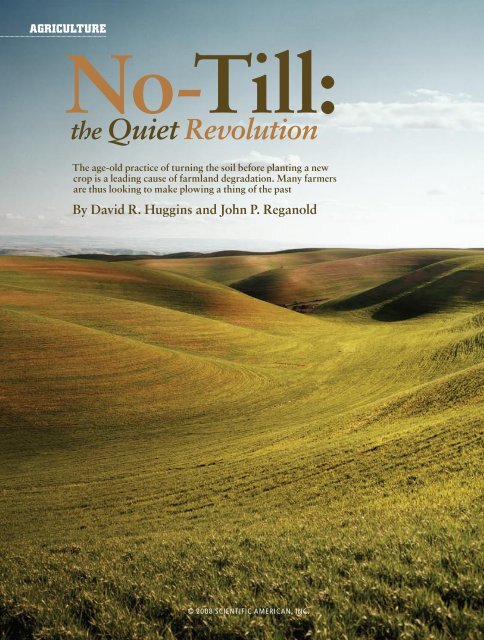
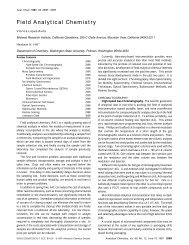
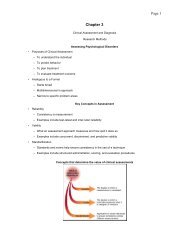


![Graduate School Policies & Procedures Manual 2011 - 2012 [PDF]](https://img.yumpu.com/50747405/1/190x245/graduate-school-policies-procedures-manual-2011-2012-pdf.jpg?quality=85)
